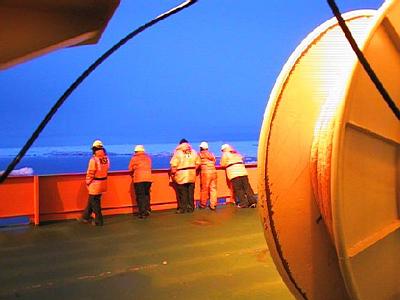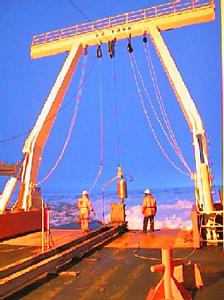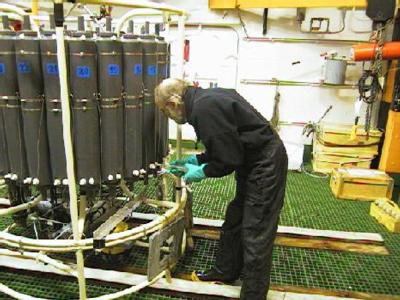
|
|
24 February, 2000
Russkaya Station
February 24, 2000
73 31 s
132 33 w
Off Hobbs Coast near Forrester Island
Temp 2.8 C (27 F), Wind 15 km/hr (9 mph) out of the south
Barometric pressure dropping
Overcast and foggy
We are in the middle of what in the old days would have been referred to
as a "trackless waste." Like yesterday and the day before, there is floe
ice in every direction as far as the eye can see (even when it is clear.)
In odd moments my mind goes back to tales of early explorers. The wind
would push the pack ice against their ships, breaking them like nuts in a
nutcracker. Then the people would be forced to fend for themselves in a
place where you can't walk, row or sail very well, and distances are
measured in hundreds of miles.
Speaking of distances, we are about 80 km (50 miles) away from shore and
about 1900 km (1180 miles) from the nearest habitation at McMurdo base.
There may be people closer, a ship or an airplane, but no station or camp.
We are about 180 km (112 miles) from the now abandoned Russian Base of
Russkaya, at the bottom of Mt. Gray. I don't know why, but the idea of
being close (in Antarctic terms) to some place of human construction
fascinates me.
I asked people on the Nathaniel B. Palmer about the base. They said it had
been closed for at least ten or fifteen years. It was evidently very
difficult to keep supplied. Food, fuel and other supplies had to be
offloaded on fast (semi-permanent) ice, and then transported to the station
itself. One year the supply ship stayed too late and got trapped in ice at
the station. An icebreaker had to come from Vladivostok, a Russian port in
the North Pacific, to break it free. The supply ship was not freed until
July, in the middle of the Antarctic winter. I imagine now Russkaya station
must be a cold, empty place, with maybe a door or window banging in the
wind, and things just as people left them years ago. Of course that's just
a guess, because we can't see it from here!
Stan Jacobs can remember when weather reports used to be relayed from
Russkaya. Now, except for the occasional passing ship, there is no weather
reporting for the whole coast between McMurdo and the Antarctic peninsula
(get a map and check it out!) The United States has a station at Siple, but
it is only occasionally occupied. The lack of weather information for this
area harms climate studies, because a great deal of the moisture for the
Antarctic continent enters in these longitudes. Later in our trip, we will
place three automatic weather stations as part of a German study, but they
are not expected to last for an extended period.
We are back up on the continental shelf, and we seem to have gone around
the worst of the ice. We are going to go eastward and find what looks like
a large area of relatively open ocean, look for the position of the shelf
break, and any glacial troughs. We have a few tantalizing hints of where
glacial troughs might be, from previous voyages. We hope to find more.
Knowing their size and position helps determine the extent of past ice caps.
We stopped to take a CTD and a piston core this evening. The crew pushed
the bow of the ship into a big floe, and ran the engines to blow clear an
area around the stern. This gave us space to lower the CTD and corer (see
today's pictures.) In a future journal, I'll explain more about piston
coring. What I had not seen before was how water samples were taken from
the CTD. So, after it had been returned to the ship and was firmly tied
down in the Baltic room, I went to watch.
Remember that the water from various depths was being tested for, among
other things, helium isotopes, and chloroflourocarbons (CFCs). Dee
Breger, is a specialist in electron microscopy from the Lamont Observatory
of Columbia University, and has published a beautiful book of electron
microscope images. She isn't on this trip to run a microscope, though. She
is the one collecting samples for helium isotope analysis. If you recall a
previous journal entry, I told you that certain helium isotopes were
produced by atmospheric hydrogen bomb tests in the 1950s and 1960s. The
winds blew these isotopes worldwide in a short time, and they mixed with
ocean surface water everywhere. When these isotopes are found at deeper
depths, it is an indication that the water with the isotopes was at the
surface when the bomb tests were being conducted. It might surprise you to
know that, although water in any one layer of the ocean mixes continually,
mixing between layers takes a long time, sometimes many years. Sometimes
oceanographers say that water has a certain "age." They are referring to
how long it has been since that water was at the surface of the sea, and
able to replenish its oxygen supply from the atmosphere.
Dee Breger explained to me how she took the samples. She attached a hose
to a spigot at the bottom of one of the bottles on the CTD. The other end
of the hose was connected to a section of copper tubing. When she opened
the spigot, water ran out through the hose and the copper tubing. When she
was sure all the air bubbles were out of the tubing, she sealed each end by
squeezing it with a clamp. The samples were then ready to be stored and
tested for helium later, on shore. She explained that she used copper
because it had a crystal structure tight enough that helium, a light, small
molecule, could not get in or out of the sample.
Guy Mathieu, also from Columbia University, was taking the samples for
CFCs. The picture with this journal entry shows him in the Baltic room. He
is carefully drawing samples with very large scary looking glass syringes.
Guy told me that CFCs are another good indicator of how "old" water is.
They are man made chemicals, manufactured since the 1930s. There are
several different types, and tests can tell the difference between the
types. He said the amount of each type sold in different time periods is
known from manufacturer's records. By looking at the ratio of types in a
water sample, tests can tell if that water was on the surface in, say, the
forties or the sixties. He said that the only ocean water on earth without
CFCs is deep water in the North Pacific Ocean.
There are also other samples being taken, but I'll have to find out about
them later. It is time for me to go ping edit, and stand geophysical watch.

Scientists philosophically contemplating the trackless waste whilst waiting for the piston corer to return to the surface.

The can shaped object hanging between the two people is the top of the piston corer, ready to start lowering to the bottom. Below this top is a long pipe (it's not visible here) that will stick into the bottom mud. The trigger weight hangs from the metal bar going down to the left. The weight hangs a few meters below the bottom of the core pipe. When the trigger weight rests on the bottom, it takes the weight off the trigger arm, releasing the piston corer to free fall into the bottom. This picture was taken at night, with a digital camera which I don't know much about.

Guy Mathieu of Columbia University takes a sample of water from one of the CTD bottles . The sample will be analyzed for CFCs, to tell when the water was last at the surface (see journal entry). He is using a large glass syringe with a metal cap, because anything plastic might contaminate the sample.
Contact the TEA in the field at
.
If you cannot connect through your browser, copy the
TEA's e-mail address in the "To:" line of
your favorite e-mail package.
|
